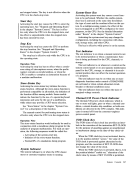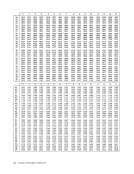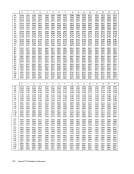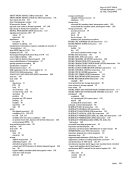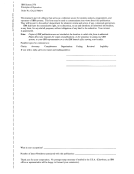Each IDA W is used for the transfer of up to 2,048 bytes. The IDA W specified by the CCW can
designate any location. Data is then transferred, for
read, write, control, and sense commands, to or from
successively higher storage locations or, for a read
backward command, to successively lower storage
locations, until a 2,048-byte block boundary is
reached. The control of data transfer is then passed
to the next IDAW. The second and any subsequent
IDAWs must specify, depending on the command,
the first or last byte of a 2,048-byte block. Thus, for
read, write, control, and sense commands, theseIDAVls will have zeros in bit positions 21-31. For a
read backward command, these IDAWs will have
ones in bit positions 21-31.EX1;ept for the unique restrictions on the specifi
cation of the data address by the IDA W, all other
rules for the data address, such as for protected stor
age and invalid addresses, and the rules for data
prefetching, remain the same as when indirect data
addressing is not used.
A channel may prefetch any of the IDAWs per
taining to the current CCW. An IDAW takes control
of the data transfer when the last byte has been
transferred for the previous IDAW for that CCW.
Errors detected in prefetched IDAWs are not indi
cated until the IDA W takes control of the data
transfer.
Name Code
Write MMMMMM01 CD CC Read MMMM MM10 CD CC Read Backward MMMM 1100 CD CC Control MMMM MM11 CD CC Sense MMMM 0100 CD CC Transfer In Channel XXXX 1000 Explanation: CD Chain data CC Chain command SLI Suppress length indication SKIP Skip PCI Program-controlled interruption I DA Indirect data addressing
M Modifier bit
XIgnored Channel Command Codes SLI SLI SLI SLI SLI The format of the IDA Wand the significance of
its fields are as follows:1000000001 Data Address
o 8 31
Bit positions0-7 are reserved for future use and
must contain zeros. If any of the bits is detected to
be a one, a program-check status condition is gener
ated, and the operation is terminated.
Bits 8-31 specify the location of the first byte to
be used in the data transfer. In the first IDAW for a
CCW, any location can be specified. For subsequent
IDAWs, depending on the command, either the first
or the last location of a 2,048-byte block located on
a 2,048-byte boundary must be specified. For read,
write, control, and sense commands, the beginning
of the block must be specified, and bits 21-31 of the
IDAW will be zeros. For a read backward command,
the end of the block must be specified, and bits 21-
31 of the IDA W will be ones. Improper data ad
dress specification causes the program-check status
conditions to be generated and causes the operation
to be terminated.
Commands
The following table lists the command codes for the
six commands and indicates which flags are defined
for each command. The flags are ignored for all
commands for which they are not defined.Flags PCI IDA SKIP PCI IDA SKIP PCI IDA PCI IDA SKIP PCI IDA Input/ Output Operations 217
designate any location. Data is then transferred, for
read, write, control, and sense commands, to or from
successively higher storage locations or, for a read
backward command, to successively lower storage
locations, until a 2,048-byte block boundary is
reached. The control of data transfer is then passed
to the next IDAW. The second and any subsequent
IDAWs must specify, depending on the command,
the first or last byte of a 2,048-byte block. Thus, for
read, write, control, and sense commands, these
read backward command, these IDAWs will have
ones in bit positions 21-31.
cation of the data address by the IDA W, all other
rules for the data address, such as for protected stor
age and invalid addresses, and the rules for data
prefetching, remain the same as when indirect data
addressing is not used.
A channel may prefetch any of the IDAWs per
taining to the current CCW. An IDAW takes control
of the data transfer when the last byte has been
transferred for the previous IDAW for that CCW.
Errors detected in prefetched IDAWs are not indi
cated until the IDA W takes control of the data
transfer.
Name Code
Write MMMM
M Modifier bit
X
its fields are as follows:
o 8 31
Bit positions
must contain zeros. If any of the bits is detected to
be a one, a program-check status condition is gener
ated, and the operation is terminated.
Bits 8-31 specify the location of the first byte to
be used in the data transfer. In the first IDAW for a
CCW, any location can be specified. For subsequent
IDAWs, depending on the command, either the first
or the last location of a 2,048-byte block located on
a 2,048-byte boundary must be specified. For read,
write, control, and sense commands, the beginning
of the block must be specified, and bits 21-31 of the
IDAW will be zeros. For a read backward command,
the end of the block must be specified, and bits 21-
31 of the IDA W will be ones. Improper data ad
dress specification causes the program-check status
conditions to be generated and causes the operation
to be terminated.
Commands
The following table lists the command codes for the
six commands and indicates which flags are defined
for each command. The flags are ignored for all
commands for which they are not defined.
























































































































































































































































